66
TVET Coordination
tracers); as of May 2012, TVET indicators and data are all supply-side focused: number of schools/VTIs, number of staff, number of students, expenditure on technical and vocational education (TVE), and so on. At the level of the training provider, there is a very weak supply-demand relationship. The lack of autonomy to be able to set up new courses, the general lack of any business representatives on institution boards, the almost complete absence of real tracer studies (let alone impact studies with control groups), as well as the lack of other government regulations and incentives contribute to this supply-demand failure (see chapter 3 for more discussion).
Coordination of Government Strategies, Plans, and Development Partner Support Government Strategies and Plans At the policy level, one finds insufficient coordination, which has led to the development of parallel agendas, plans, programs, and committees. The fragmentation of TVET provision (see also chapter 3) is mirrored by a fragmentation of TVET policies and strategies among—and within—the main TVET-delivering ministries. So, for example, the NVTI (under MoELR) has a strategy, Opportunities Industrialization Center (OIC) (MoELR) has a strategy, ICCES (MoELR) has never really had a strategy, and meanwhile the MoELR itself does not have an overall TVET strategy. The MoE TTIs and their secondary technical schools are linked to the Education Strategic Plan. Meanwhile, COTVET is busy setting up new committees and frameworks. Moreover, some confusion still exists about the mandates of various entities, and some existing legislation is contradictory. A case in point is the state of affairs between the NVTI and COTVET when it comes to informal apprenticeship. On the one hand, the NVTI has its National Apprenticeship Council, which is backed by Legislative Instrument Apprentice Regulation LI 1151 of 1978, to “oversee all matters concerning apprenticeship in the country.”5 On the other hand, in April 2010, the COTVET Board set up a National Apprenticeship Committee “to formulate and supervise the implementation of a national apprenticeship policy” (COTVET 2010: 9). COTVET’s National Apprenticeship Strategy (COTVET 2010) makes no reference to the NVTI National Apprenticeship Council. We have already noted the dual-track policy-making process of the New Education Reform (NER) and the Education Strategic Plan (ESP) (see chapter 1), as well as the fragmentation of policies and strategies of TVET-providing ministries, but we should also highlight that numerous other strategies, plans, programs, or policies exist that relate, in whole or in part, to TVET.6 Little attention has been given to the obvious synergies and interlinkages that exist between these agendas. For example, the National Development Planning Commission (NDPC) (2010a) “Medium-Term National Development Policy Framework” for 2010–13 outlines the general strategies proposed for TVET, without going in to any detail. It simply states that, regarding TVET, policy interventions include Demand and Supply of Skills in Ghana • http://dx.doi.org/10.1596/978-1-4648-0280-5
